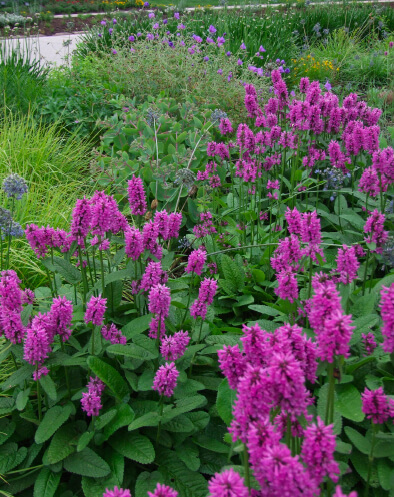Pollinators are abuzz for the 2019 Perennial of the Year
By selecting Stachys officinalis ‘Hummelo’ as its 2019 Perennial Plant of the Year, the Perennial Plant Association once again continued its focus on pollinator-friendly plants.
‘Hummelo’ is a compact, clump-forming perennial, reaching 1.5 to 2 feet tall and wide. Over time, the plants will form a dense mat, spreading slowly from creeping underground stems. Showy magenta flower spikes rise well above the foliage in midsummer and are quite attractive to butterflies and other pollinators. Plants are hardy in USDA Hardiness zones 4-8 and appear to be trouble-free. Plants perform best in full sun and well-drained soil. ‘Hummelo’ was the highest rated Stachys in the Chicago Botanic Garden Evaluation Trials for its strong flower production, vigor, habit, quality and winter hardiness.
The Perennial Plant Association selects a different perennial plant each year to promote throughout the nursery and gardening industry. PPA members nominate plants based on several criteria, including low maintenance needs, adaptability to a wide range of climates, pest and disease resistance, wide availability, multiple seasons of interest, and ease of propagation. A selection committee narrows the field to three or four choices, and then members cast votes.
For more information about the Perennial of the Year program, see www.perennialplant.org.
Previous PPA Perennial Plant of the Year winners:
- 2018 Allium ‘Millenium’ (ornamental onion)
- 2017 Asclepias tuberosa (butterfly milkweed)
- 2016 Anemone x hybrida ‘Honorine Jobert’ (windflower)
- 2015 Geranium ‘Biokova’ (dwarf cranesbill, hardy geranium)
- 2014 Panicum virgatum ‘Northwind’ (tall switch grass)
- 2013 Polygonatum odoratum var. variegatum (Solomon’s seal)
- 2012 Brunnera macrophylla ‘Jack Frost’ (Siberian bugloss)
- 2011 Amsonia hubrichtii (blue star)
- 2010 Baptisia australis (blue false indigo)
- 2009 Hakonechloa macra, ‘Aureola’ (Japanese forest grass)
- 2008 Geranium ‘Rozanne’ (cranesbill, hardy geranium)
- 2007 Nepeta racemosa ‘Walker’s Low’ (catmint)
- 2006 Dianthus ‘Feuerhexe’ (aka ‘Firewitch’) (cheddar pink)
- 2005 Helleborus x hybridus (hellebore, Lenten rose)
- 2004 Athyrium niponicum var. pictum (Japanese painted fern)
- 2003 Leucanthemum x superbum ‘Becky’ (shasta daisy)
- 2002 Phlox paniculata ‘David’ (garden phlox)
- 2001 Calamagrostis x acutiflora ‘Karl Foerster’ (feather reed grass)
- 2000 Scabiosa ‘Butterfly Blue’ (pincushion flower)
- 1999 Rudbeckia fulgida var. sullivantii ‘Goldsturm’ (black-eyed Susan)
- 1998 Echinacea purpurea ‘Magnus’ (purple coneflower)
- 1997 Salvia x sylvestris ‘Mainacht’ (aka ‘May Night’) (wood sage)
- 1996 Penstemon digitalis ‘Husker Red’ (beardtongue)
- 1995 Perovskia atriplicifolia (Russian sage)
- 1994 Astilbe ‘Sprite’ (dwarf astilbe)
- 1993 Veronica ‘Sunny Border Blue’ (speedwell)
- 1992 Coreopsis verticillata ‘Moonbeam’ (threadleaf coreopsis)
- 1991 Heuchera micrantha var. diversifolia ‘Palace Purple’ (coral bells)
- 1990 Phlox stolonifera (creeping phlox)
